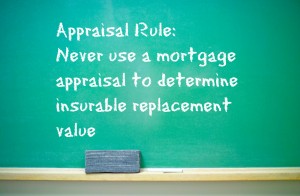I got a question recently from a homeowner whose house I recently appraised for the purchase mortgage. They wanted to know if they could use the appraisal to determine how much the home should be insured for. I’ve gotten this question before so I thought I would share with you my answer since it seems that others are wondering this same thing.
First off I want to say that an appraisal provided to a bank for mortgage lending should only be used for that purpose, as it is specifically performed to meet the needs of the client that ordered it. The bank is concerned with the market value of the property, or what they could sell it for if they had to take it back through foreclosure. There are three recognized approaches to value in a mortgage appraisal and include the cost, sales comparison, and income approach to value. Of these three approaches the cost and sale comparison approach are the most widely used. The income approach is mainly used for income producing properties and when rental information is readily available to develop this approach to value.
to meet the needs of the client that ordered it. The bank is concerned with the market value of the property, or what they could sell it for if they had to take it back through foreclosure. There are three recognized approaches to value in a mortgage appraisal and include the cost, sales comparison, and income approach to value. Of these three approaches the cost and sale comparison approach are the most widely used. The income approach is mainly used for income producing properties and when rental information is readily available to develop this approach to value.
The cost approach reflects the cost of new construction and how much it would take to rebuild a home that is similar to what is being appraised, but it also includes depreciation, taking into consideration how old the house is and what type of condition it is in. The estimate by the cost approach provides a depreciated cost of the improvements, and includes the value of the land. This would not be adequate for insurance replacement purposes.
The sales comparison approach to value compares the property being appraised to other similar homes that have recently sold. The sales price of these “comps” reflects the age and condition of the property as well as including the land. Also included in the price may be functional and external forms of depreciation, meaning that if a home has a bad floor plan or is located next to a negative influence this will typically result in a lower sale price.
So as you can see, the appraisal reflects value related items, both positive and negative, that are not included by an insurance company when they calculate a replacement cost for your home and improvements, so it is not a good idea to use the appraisal to determine insurance coverage. If you have ever done this, how did it turn out? Leave me a message below if you have anything to add to the discussion, I would be happy to hear your point of view.
If you have any real estate appraisal related questions you can call me at 205.243.9304, email me, or connect with me on Facebook., Twitter, or Youtube.
The cost approach was once called the summation approach. The theory is that the value of a property can be estimated by summing the land value and the depreciated value of any improvements. The value of the improvements is often referred to by the abbreviation RCNLD (reproduction cost new less depreciation or replacement cost new less depreciation). Reproduction refers to reproducing an exact replica. Replacement cost refers to the cost of building a house or other improvement which has the same utility, but using modern design, workmanship and materials. In practice, appraisers almost always use replacement cost and then deduct a factor for any functional dis-utility associated with the age of the subject property. An exception to the general rule of using the replacement cost, is for some insurance value appraisals. In those cases, reproduction of the exact asset after the destructive event (fire, etc.) is the goal.
Thanks for sharing your thoughts, I appreciate the input.
I don’t agree with you. I think that theory is still valid.
Thanks for your comments, Alex. What exactly do you disagree with and what about the theory do you think is valid?